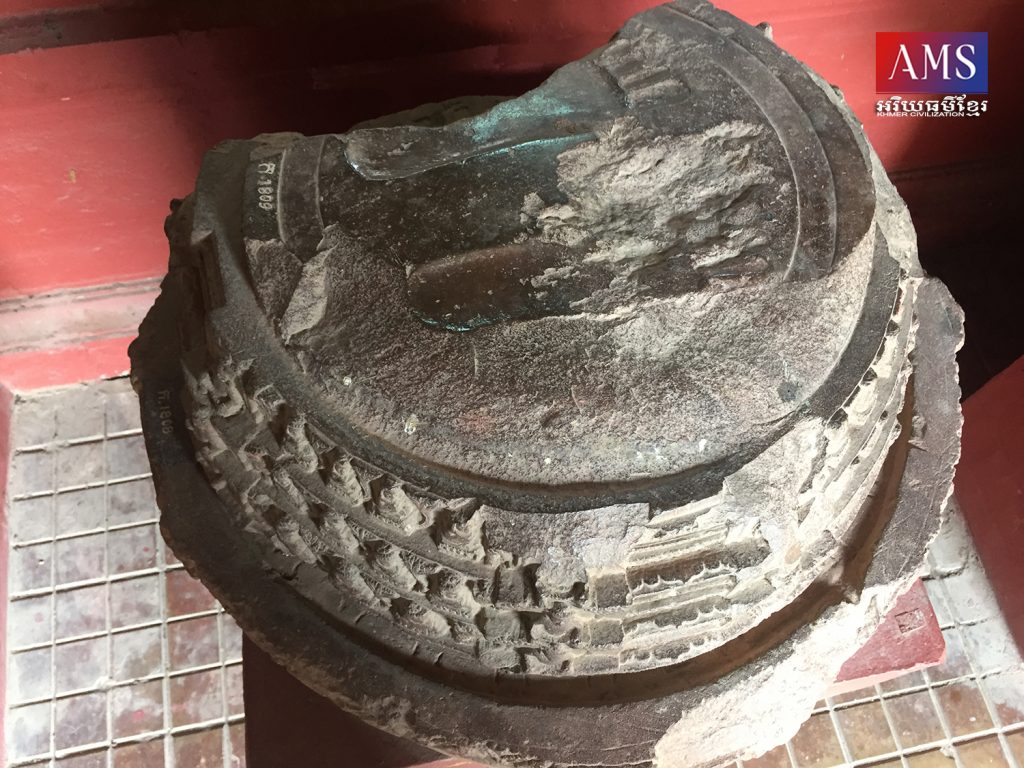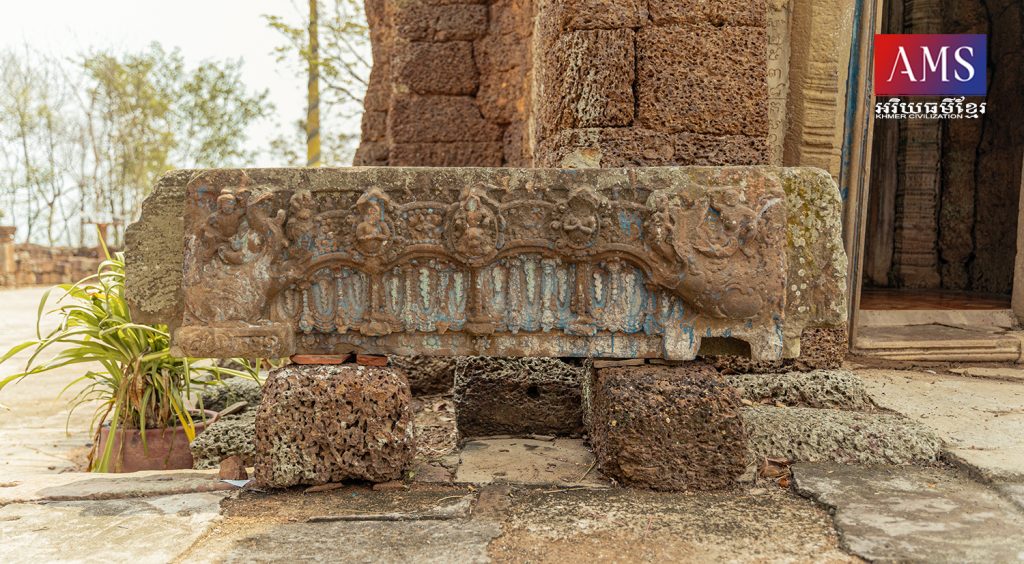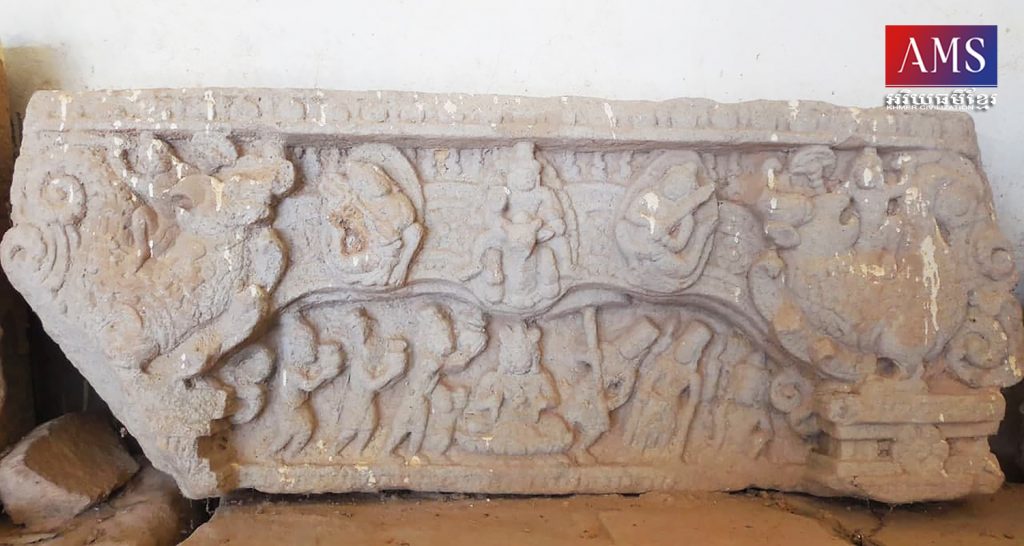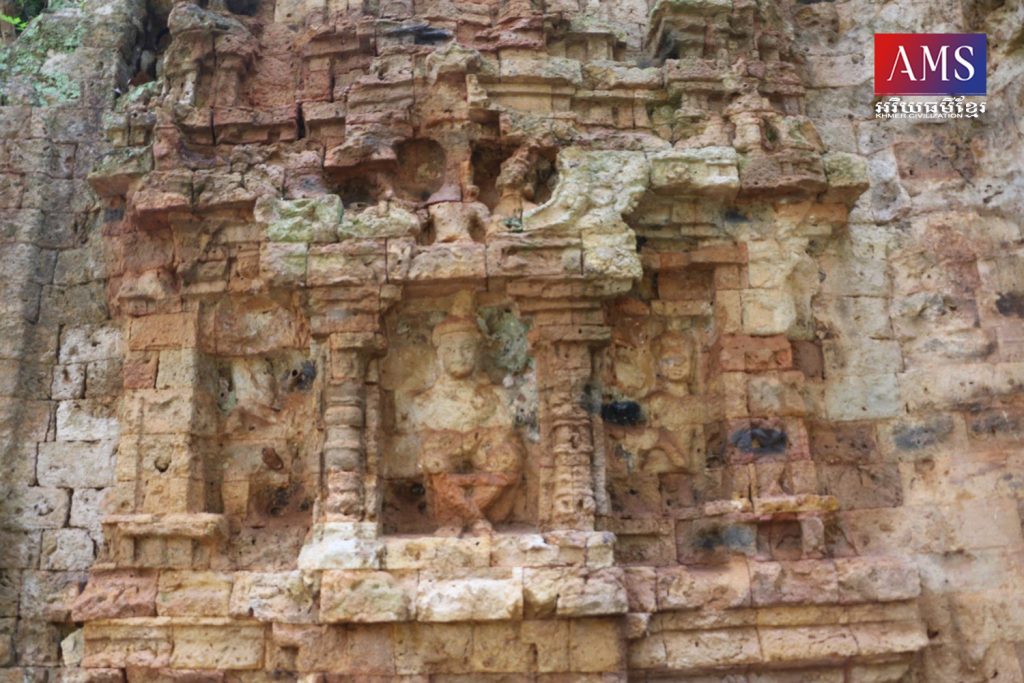ព្រះឥសូរ គឺជាទេពធំជាងគេនៅក្នុងព្រហ្មញ្ញសាសនា។ ទ្រង់មានព្រះនាមច្រើនណាស់ តែព្រះនាមដែលគេច្រើនស្គាល់មានដូចជា សិវ ហរ មហេស្វរ រុទ្រ ឧគញរ អឃោរ ភៃរវ ។ល។ ព្រះឥសូរមានព្រះនេត្របី មានចំណិតព្រះចន្រ្ទលើផ្នួងសក់ ព្រះហស្តពីរ បួន ប្រាំបី និងដប់ ហើយភាគច្រើនតែងមានយានជំនិះជាសត្វគោនន្ទិ និងពេលខ្លះជិះសត្វផ្សេងៗទៀតទៅតាមរូបភាពរបស់ទ្រង់។ នៅក្នុងព្រះហស្ថរបស់ព្រះឥសូរមានកាន់ថូរ ស្គរ ផ្គាំ លលាដ៏ក្បាល ត្រីសូល៍ និងខ្សែ។ ទ្រង់មានតួនាទីបង្កើតលោក និងបំផ្លាញលោកចាស់ ដើម្បីបង្កើតលោកថ្មីមួយទៀត។
នៅសម័យមុនអង្គរ នាស.វ.ទី៧-៨ ខ្មែរនិយមឆ្លាក់រូបព្រះលិង្គតំណាងឲ្យព្រះឥសូរ និងពុំសូវនិយមឆ្លាក់រូបព្រះឥសូរក្នុងទម្រង់រូបភាពដូចមនុស្សទេ ពោល គឺមានតិចតួចបំផុត។ ក្រៅពីនេះ នៅសម័យមុនអង្គរខ្មែរបានឆ្លាក់រូបត្រីសូល៍ និងព្រះបាទតំណាងឱ្យព្រះឥសូរក៏មាន។ ដោយឡែក ចម្លាក់ព្រះឥសូរដែលបង្ហាញទម្រង់ដូចមនុស្សនៅស.វ.ទី៧ គេបង្ហាញពីរប្រភេទ។ ប្រភេទទី១ គឺចម្លាក់ព្រះឥសូរជិះលើយានជំនិះជាសត្វផ្សេងៗ និងប្រភេទទី២ គឺចម្លាក់ព្រះឥសូរក្នុងទម្រង់ជាឥសី។
នៅក្នុងសិល្បៈខ្មែរនាស.វ.ទី៧ យ៉ាងតិចក៏មានចម្លាក់ព្រះឥសូរចំនួនបួន ដែលសិល្បករឆ្លាក់ឡើងដោយមានជិះលើសត្វផ្សេងៗ។ រូបភាពទី១ យើងសូមបង្ហាញអំពីចម្លាក់មួយនៅលើផ្តែរទ្វារដែលរកឃើញនៅប្រាសាទភ្នំធំ (ខ្លះហៅភ្នំជើងព្រៃ) ដែលស្ថិតនៅស្រុកជើងព្រៃ ខេត្តកំពង់ចាម។ ចម្លាក់នេះគេឆ្លាក់នៅលើក្បាច់រាងរង្វង់ (មេដាយ៉ុង) ស្ថិតនៅចំកណ្តាលផ្តែរដោយមានយានជំនិះជិះលើសត្វតោ។ ជាទូទៅ ការបង្ហាញចម្លាក់ព្រះឥសូរមានយានជំនិះសត្វតោ នៅសម័យមុនអង្គរ យើងទំនងពុំធ្លាប់ឃើញមាននៅកន្លែងផ្សេងនោះទេ។ ប៉ុន្តែ នៅសម័យអង្គរ ការបង្ហាញបែបនេះយើងជួបច្រើនកន្លែង ពោល ដូចជានៅប្រាសាទព្រះធាតុបាស្រី (ខេត្តកំពង់ចាម) ប្រាសាទភិមាយ (ប្រទេសថៃបច្ចុប្បន្ន) ចម្លាក់នៅពើងគំនូរ ភ្នំគូលែន (ខេត្តសៀមរាប)។ ម្ល៉ោះហើយ យើងអាចសន្និដ្ឋានបានថាចម្លាក់នៅចំកណ្តាលផ្តែរទ្វារមួយស.វ.ទី៧នៅភ្នំធំ ទំនងជារូបព្រះឥសូរមានយានជំនិះសត្វតោ។ រូបភាពទី២ ចម្លាក់ព្រះឥសូរមានយានជំនិះសត្វគោនន្ទិឆ្លាក់លើផ្តែរទ្វារ ប្រាសាទទួលព្រះធាតុ ស្រុកកណ្តាលស្ទឹង ខេត្តកណ្តាល ហើយសព្វថ្ងៃរក្សាទុកនៅសារមន្ទីរជាតិកម្ពុជា។ នៅលើផ្តែរទួលព្រះធាតុ គេឆ្លាក់ព្រះឥន្រ្ទគង់នៅលើដំរីព្ធវ៌តនៅចំកណ្តាល រូបព្រះឥសូរគង់នៅលើគោនន្ទិនៅខាងឆ្វេង និងមានរូបព្រាហ្មណ៍ម្នាក់លត់ជង្គង់ខាងស្តាំព្រះឥន្រ្ទ។ ចម្លាក់ព្រះឥសូរគង់នៅខាងឆ្វេងព្រះឥន្រ្ទរបៀបនេះ យើងកម្រឃើញមានណាស់នៅក្នុងសិល្បៈខ្មែរ ហើយលោក Lunet De Lajonquière និងលោក Henri Parmetier យល់ថាទំនងជារូបភាពបង្ហាញពីព្រះរាជពិធីថ្វាយព្រះភ្លើង។ រូបភាពទី៣ ចម្លាក់ព្រះឥសូរមានយានជំនិះសត្វគោនន្ទិ ឆ្លាក់នៅលើផ្តែរទ្វាររកឃើញនៅស្រុកស្វាយជ្រុំ ខេត្តស្វាយរៀង ហើយសព្វថ្ងៃរក្សាទុកនៅសារមន្ទីរជាតិភ្នំពេញ។
ចម្លាក់ព្រះឥសូរនេះ គេឆ្លាក់នៅកណ្តាល ដែលខាងឆេ្វងមានព្រះវិស្ណុ និងខាងស្តាំមានព្រះព្រហ្ម។ ចម្លាក់របៀបនេះគេច្រើនហៅថា “ត្រីមូត៌ិ” ហើយប្រពៃណីឆ្លាក់បែបនេះមានបន្តនៅសម័យអង្គរច្រើន។ រូបភាពទី៤ ចម្លាក់ព្រះឥសូរមានយានជំនិះសត្វគោនន្ទិ ឆ្លាក់នៅចំកណ្តាលផ្នែកខាងលើ នៃផ្តែរទ្វារវត្តប្រាសាទ ក្នុងភូមិប្រាសាទ ឃុំជ្រៃឃ្មុំ ស្រុកស៊ីធរកណ្តាល ខេត្តព្រៃវែង ហើយសព្វថ្ងៃរក្សាទុកនៅសារមន្ទីរខេត្តព្រៃវែង។ ផ្តែរទ្វារនេះមានទម្រង់សិល្បៈរចនាបថសំបូរព្រៃគុក ស.វ.ទី៧ ដោយមានផ្នែកខាងក្រោមឆ្លាក់បង្ហាញអំពីពិធីស្រោចទឹក។ នៅផ្នែកខាងក្រោម យើងឃើញរូបព្រះនាងលក្ស៊ីគង់នៅផ្កាឈូកចំពាក់កណ្តាល ដែលជាតួអង្គត្រូវពួកព្រាហ្មណ៍ស្រោចទឹកជូន ហើយនៅខាងចុងផ្នែកខាងឆ្វេងយើងឃើញមានចម្លាក់ព្រះព្រហ្ម និងព្រះវិស្ណុ។ អ្វីគួរចាប់អារម្មណ៍នោះគឺចម្លាក់គោនន្ទនៅលើផ្តែរទ្វារវត្តប្រាសាទមានលក្ខណៈដូចផ្តែរទ្វារទួលព្រះធាតុ ហើយរូបគោគេឆ្លាក់បែរមុខចំ ដែលខុសពីផ្តែរទ្វារមកពីស្វាយជ្រុំ ខេត្តស្វាយរៀង គេឆ្លាក់រូបគោនន្ទិចំហៀង។
ចំណែក ចម្លាក់ព្រះឥសូរក្នុងទម្រង់ជាឥសី យើងឃើញមានឆ្លាក់នៅលើផ្តែរទ្វារប្រាសាទសណ្តាន់ (តួប៉ម N.21) នៃតំបន់ប្រាសាទសំបូរព្រៃគុក។ ចម្លាក់នេះឆ្លាក់ឡើងនៅក្នុងក្បាច់មេដាយ៉ុងចំពាក់កណ្តាលផ្តែរ ក្នុងកាយវិការលើកព្រះហស្តទាំងពីរដាក់គងលើគ្នាដូចកាយវិការសមាធិ។ អ្នកស្រាវជ្រាវខ្លះយល់ថា រូបនេះជាព្រះពុទ្ធអង្គកំពុងសមាធិ ប៉ុន្តែលោកស្រី Mireille Bénisti បានសិក្សាឡើងវិញ និងបានឱ្យសេចក្តីសន្និដ្ឋានថាជាចម្លាក់ព្រះឥសូរក្នុងទម្រង់យោគិស្វរ ពោល គឺឥសូរក្នុងទម្រង់ជាឥសីតាំងសិល្បិ៍ក្នុងព្រៃ។ ចម្លាក់របៀបនេះ យើងធ្លាប់ជួបនៅលើផ្តែរទួលក្តីក្នុង ស្រុកស្រីសន្ធរ ខេត្តកំពង់ចាម ប៉ុន្តែសព្វថ្ងៃផ្តែរទ្វារនេះបានបាត់បង់ពីទីតាំងដើមទៅហើយ។ ក្រៅពីនេះ យើងធ្លាប់ឃើញមានចម្លាក់ឥសីឆ្លាក់នៅលើក្បាច់វិមានអណ្តែត តួប៉ម N11 និង តួប៉ម N15 នៃក្រុមខាងជើងតំបន់ប្រាសាទសំបូរព្រៃគុក។
ជារួមមក យើងសង្កេតឃើញថាភស្តុតាងការគោរពព្រះឥសូរនៅកម្ពុជានាសម័យមុនអង្គរ យើងច្រើនឃើញគេនិយមសាងសង់ជាព្រះលិង្គជាតំណាងឲ្យព្រះឥសូរ។ ចំណែក រូបភាពព្រះឥសូរក្នុងទម្រង់រូបភាពដូចមនុស្ស និងទម្រង់ជាឥសីមានមិនច្រើននោះទេ។
———————————————-
Shiva sculpture in the Pre-Angkorian
Shiva is the greatest god in Hinduism. He has many names, but the most well-known names are Shiva, Hara, Maheśvara, Rudra, Okra, Aghora, Bhairava, etc. Shiva has three eyes, the third eye on his forehead is the eye with great power. He has two, four, eight, and ten hands, and mostly he rides on Nanti as his vehicle and sometimes other animals according to his image. In his hand, he carries Kamaṇḍalu, Ḍamaru, Aksamãlã, Skull, Trident, and strings. He has the role of creating the universe and destroying the old to create a new universe.
In the pre-Angkorian of the 7th-8th centuries, the Khmer commonly carved statues of the Linga representing Shiva and less popularly carved the statue in the form of a human figure, that is, very few. In addition, in the pre-Angkorian, Khmer carved statues of Trident and kings representing Shive. In particular, there are two types of sculptures that show the human form in the 7th century. The first type is the statue of Shiva riding on a vehicle as various animals and the second type is the sculpture of Shiva in the form of the hermit.
In Khmer art 7th century, there were at least four statues of Shiva carved by artists riding on various animals. Firstly, a sculpture on the lintel found at Phnom Thom temple or Phnom Cheung Prey located in Cheung Prey District, Kampong Cham province. The sculpture is carved on a medallion which shows Shiva riding on a lion as his vehicle. In general, the display of Shiva with his vehicle lion in pre-Angkorian is unlikely to be found anywhere else. However, during the Angkorian, such encounters were found in many places namely at Preah Theat Basrey temple (Kampong Cham province), Phimai temple (Thailand), and sculptures Peung Kumnu at Phnom Kulen (Siem Reap province). Thus, we can conclude that the sculpture in the middle of a lintel in the 7th century in Phnom Thom is likely a vehicle lion of Shiva. Secondly, the sculpture of Shiva at Tuol Preah Theat temple, Kandal Steung district, Kandal province, shows Shiva sitting on a Nanti on the left, and a Brahmin kneeling on the right. Shiva sculptures on the left side of Indra like this are rare in Khmer art, and Lunet De Lajonquière and Henri Parmetier realized that it is likely the images of royal cremation. Thirdly, the sculpture of Shiva has a Nanti vehicle on the lintel found in Svay Chrum district, Svay Rieng province, and is now kept at the National Museum in Phnom Penh. This sculpture is carved in the center, with Vishnu on the left and Brahma on the right. This type of sculpture is often called “Trimouti or Trident” and this tradition of carving continues in the Angkorian. Fourth, the sculpture of Shiva has a Nanti vehicle in the middle of the upper part of the lintel of Wat Prasat in Chrey Khmum commune, Sithor Kandal district, Prey Veng province, and is now kept at the Prey Veng Provincial Museum. This lintel has an art form in the style of Sambor Prei Kuk, 7th century, with the lower part carved to show the watering ceremony. At the bottom we see the statue of Laksmi sitting in the middle of the lotus, the character is watered by the Brahmins, and at the far left, we see the sculpture of Brahma and Vishnu. What is interesting is that the Nanti on the lintel of Wat Prasat is similar to the lintel of Tuol Preah Theat, and the Nanti is carved facing forward, which is different from the lintel from Svay Chrum, Svay Rieng province because it was carved on the other part on the lintel.
Whereas, the sculpture of hermit form found on the lintel of Sandan temple (Tower N.22) of Sambor Prei Kuk temple area. This sculpture is carved in the middle of the medallion in the gesture of raising both hands upward like a meditation gesture. the scholars consider that this image was meditating, but Mireille Bénisti re-examined and concluded that it was a Shiva sculpture in the form of a Yogi, that is, he is a form of a hermit in the forest. This kind of sculpture we used to see on the Tuol Kdei Knong in Srey Santhor district, Kampong Cham province, but today this transfer has disappeared from its original location. In addition, we have seen carvings on the floating temple, N11 towers, and N15 towers of the northern group of Sambor Prei Kuk temples.
Overall, we observe that the evidence of the worship of the Shiva in Cambodia in the Pre-Angkorian, we often see the linga built as a representing of the Shiva. There are not many Shiva in the form of human image and hermit.
អត្ថបទដើម៖ លោក ម៉ង់ វាលី










